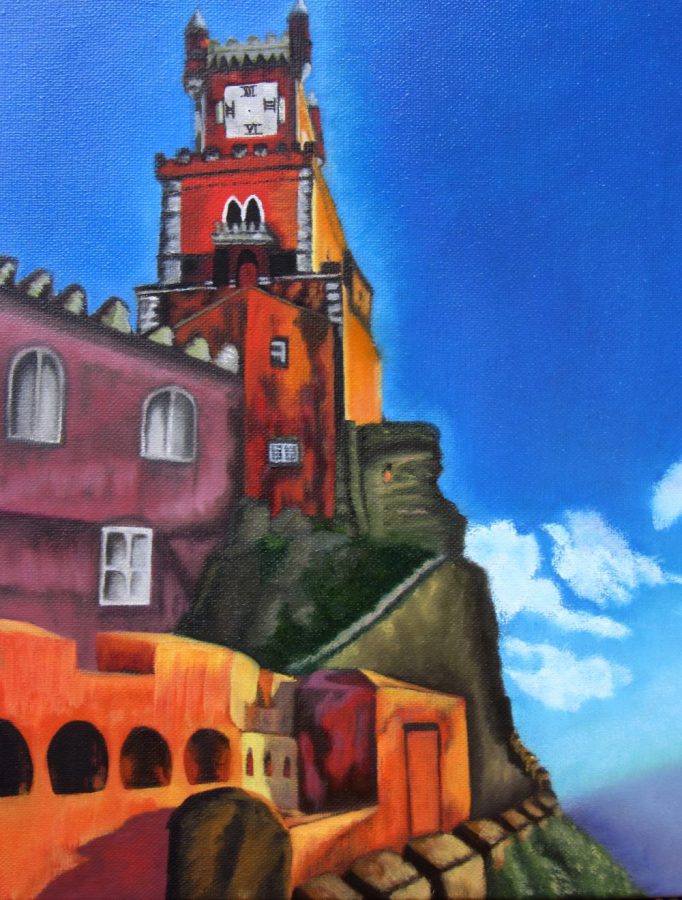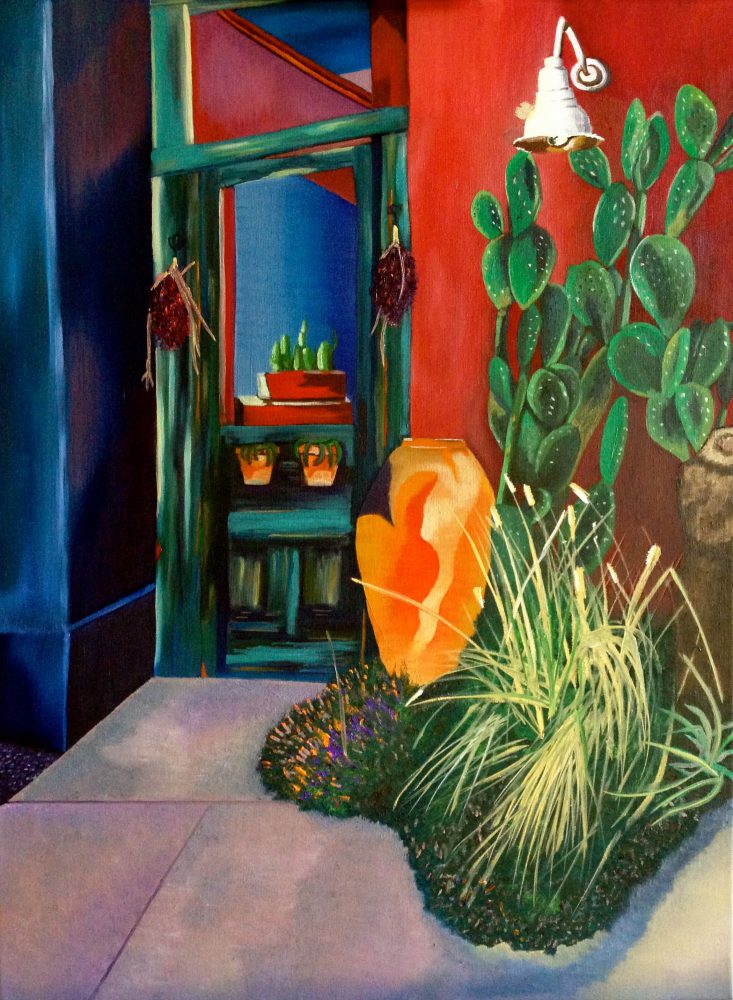I finally discovered the history and story behind the painting I did years ago, entitled, “Church”. If you’re interested in finding out more, select the link, and I’ll give you a little history about the beautiful Pena Palace in Sintra, Portugal.
Category Buildings
La Maison Rose
Upon returning from Paris, I decided my first painting from the trip would be the quaint pink house turned bistro at 2 Rue de l’Abreuvoir, Montmartre. I began the painting process in Mid-April and just finished up a couple of weeks ago, taking a hiatus to create the 5th grade promotion video for my sons’ class.
Because of the hilly nature of the Montmartre landscape, the perspective on this one was extremely difficult. From where I took the photograph, the bistro and street corner were slightly below me receding into the distance at a slight angle. Not one single point was straight!
While researching La Maison Rose, I learned that Picasso himself had frequented the place and that it was home of Germaine Pichot, a well known painting model and notorious femme fatale. Picasso and Carlos Casagemas, Picasso’s best friend, met Germaine when they first came to Paris in 1900. Carlos fell madly in love with Germaine, but the feelings were not mutual.
In 1901, in his grief and drunkenness, Carlos attempted to shoot Germaine. He missed his target and instead turned the gun on himself. Shocked and saddened by his friend’s death, Picasso fell into a depression. It was this tragic incident that provoked his Blue Period. Germaine was depicted in Picasso’s 1905 painting At the Lapin Agile shown below.


The Blind Man’s Meal is one of Picasso’s most moving pictures from his Blue Period (autumn 1901–mid-1904). Most prevalent among his subjects were the old, the destitute, the blind, the homeless, and the otherwise underprivileged outcasts of society. The painting is not merely a portrait of a blind man; it is also Picasso’s commentary on human suffering in general. Additionally, the work elicits affinities to Picasso’s own situation at the time, when, impoverished and depressed, he closely identified with the unfortunates of society. (Metropolitan Museum of Art)
The destitute outcasts featured in Picasso’s Blue Period gave way, in 1905, to circus performers and harlequins in more colorful settings. The Lapin Agile was originally conceived to decorate a bar in Montmartre, the interior of which is depicted here. Standing at the counter is Picasso himself, dressed as the melancholy and gaunt Harlequin in a vivid diamond-patterned shirt and three-cornered hat. Behind him, in profile with heavy makeup and pouty lips, leans Germaine Pichot, wearing a gaudy orange dress, bead choker, boa, and feathered hat. (Metropolitan Museum of Art)
Reflection
Suzanne
My girlfriend Suzanne turned 45 in July. Instead of buying her a birthday gift, I offered to create a painting for her. Initially I had something completely different in mind but it didn’t work out as I envisioned. It took a while to find something that “felt” like Suzanne and was true to my aesthetic.
I stumbled upon this photo on Pinterest and fell in love with the composition, the subject matter, and the colors. I started painting in early October and finished it up a week ago. That’s the hardest part for me: finding the time to allocate to my art. I need a good chunk of uninterrupted time to really get into the groove. And once I do, it’s very hard for me stop and take a break.
I am not a morning person at all and tend to feel my best physically and mentally in the afternoon and evening. It’s a real challenge juggling all the hats: mother, wife, homemaker, volunteer, and artist successfully. One of my artistic goals is to become a faster painter. I’m sure it will come with more experience — at least I hope so!
Church
UPDATE
So, about a year ago, I stumbled on a website with this church. It is called Pena Palace and is located in Sintra Portugal. At that time I failed to update this Post. However, just the other day, while browsing my social media feed, a friend of mine posted photos from their family summer trip. And lo and behold, this beautiful church was the focal point! And this time I knew I had to follow through. So I did some digging and discovered that this incredible site began as the Royal Monastery of Our Lady of Pena dating back to the 12th century. The structure was destroyed by the earthquake that hit Lisbon in 1755, after which time it lay in ruins until the 1840s when it was rebuilt by King Ferdinand II and Queen Maria II.
King Ferdinand II was one of the most cultured men of 19th century Portugal. He spoke many languages, and as a young Duke, was afforded a thorough education, including the arts. During his entire life, he maintained a deep connection with the arts whether as an artist, collector or sponsor and becoming known nationally as the King-Artist.

A few months ago I discovered this incredible photograph of a beautiful church on line. I fell in love with the bright vibrant colors and knew I had to paint it.
The first step was to paint the blue background. Once that was dry it was time to tackle the drawing. Given the “ant” perspective, I knew it would be very tricky and would not look right if the drawing itself wasn’t correct. Therefore, I drew a grid on the photograph composed of 1″ square blocks.
Next, I transferred the grid to the canvas using a 2:1 ratio. Using a charcoal pencil, I drew in the image.

Below is the finished painting. If anyone knows which church this is or its whereabouts, please let me know! Now that I have spent many hours with it, I would love to know the history!

Venice
In between learning to paint with oils, I needed to create something in a familiar medium, to remind myself that I can do this! I came across this incredible picture of Venice, Italy on Facebook. My depiction doesn’t do Venice justice, but I like the overall feel, especially the water. This was also a great learning experience in perspective. It’s been since my Design days, about 20 years, that I have tackled perspective drawing. So, I had to dig deep in my memory bank to retrieve those lessons. It’s not perfect, but nothing ever is.
Yellow House

For this assignment we each chose a photograph to use for inspiration. Our teacher, Lois Jones, is teaching us how to edit what we see instead of painting the entire photograph. First we use a viewfinder to crop the image, then do quick charcoal sketches. From there, we pick the sketch that speaks to us.
I was drawn to the bright purple flowers and green grass against the pale house. I love the combination of gold, purple, and green so I decided to make the house more of a golden color. I really struggled with the trees; in the picture they were barely visible. I gave them more life by using a pointillism technique. Overall, I was very happy with the end result.










